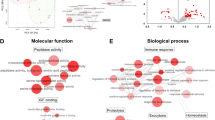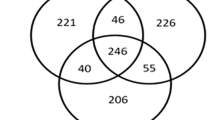Abstract
Purpose
Primary angle-closure glaucoma (PACG) is associated with increased intraocular pressure, optic nerve damage, and progressive vision loss, but the molecular mechanism that underpins retinal ganglion neuropathy in PACG remains poorly understood. To better understand the pathogenesis of human PACG, we performed the first comprehensive proteomic analysis of aqueous humor (AH) samples from PACG patients and matched control donors to study pathogenic alteration in AH composition in disease.
Methods
High-resolution, label-free, liquid chromatography–tandem mass spectrometry-based quantitative proteomic analyses were performed in AH samples collected from PACG patients and a matched control cohort of patients with cataracts.
Results
The AH proteome comprised of 1363 distinct proteins, of which more than 50% were differentially expressed in PACG (773 total; 501 up-regulated, 272 down-regulated). AH from PACG patients was enriched in atypical collagens and fibronectins, suggesting that the composition of the trabecular matrix is significantly altered in disease. Pathway and cluster analyses revealed that AH protein modulation in PACG is closely associated with biological processes including platelet degranulation, cellular import/export mechanisms, and control of protease activity. In addition, critical mediators of oxygen homeostasis and neuronal function in AH were significantly dysregulated in disease, strongly implicating oxidative stress responses in PACG-associated nerve damage.
Conclusions
Altered AH proteome in human PACG indicated oxidative stress in the neuronal damage that preceded vision loss. Identifying key mediators of PACG pathology will yield new prognostic biomarkers and novel targets for future therapeutic interventions.






Similar content being viewed by others
References
Quigley HA, Broman AT (2006) The number of people with glaucoma worldwide in 2010 and 2020. Br J Ophthalmol 90(3):262–267
Tham YC, Li X, Wong TY, Quigley HA, Aung T, Cheng CY (2014) Global prevalence of glaucoma and projections of glaucoma burden through 2040: a systematic review and meta-analysis. Ophthalmology 121(11):2081–2090
Quigley HA, Friedman DS, Congdon NG (2003) Possible mechanisms of primary angle-closure and malignant glaucoma. J Glaucoma 12(2):167–180
Heijl A, Leske M, Bengtsson B et al (2002) Reduction of intraocular pressure and glaucoma progression: results from the early manifest glaucoma trial. Arch Ophthalmol 120(10):1268–1279
Sacca SC, Gandolfi S, Bagnis A, Manni G, Damonte G, Traverso CE, Izzotti A (2016) The outflow pathway: a tissue with morphological and functional unity. J Cell Physiol 231(9):1876–1893
Izzotti A, Sacca SC, Longobardi M, Cartiglia C (2009) Sensitivity of ocular anterior chamber tissues to oxidative damage and its relevance to the pathogenesis of glaucoma. Invest Ophthalmol Vis Sci 50(11):5251–5258
Tripathi RC, Millard CB, Tripathi BJ (1989) Protein composition of human aqueous humor: SDS-PAGE analysis of surgical and post-mortem samples. Exp Eye Res 48(1):117–130
Faria SS, Morris CF, Silva AR, Fonseca MP, Forget P, Castro MS, Fontes W (2017) A timely shift from shotgun to targeted proteomics and how it can be groundbreaking for cancer research. Front Oncol 7:13
Ji Y, Rong X, Ye H, Zhang K, Lu Y (2015) Proteomic analysis of aqueous humor proteins associated with cataract development. Clin Biochem 48(18):1304–1309
Yao J, Chen Z, Yang Q, Liu X, Chen X, Zhuang M, Liu Q (2013) Proteomic analysis of aqueous humor from patients with branch retinal vein occlusion-induced macular edema. Int J Mol Med 32(6):1421–1434
Yao J, Liu X, Yang Q, Zhuang M, Wang F, Chen X, Hang H, Zhang W, Liu Q (2013) Proteomic analysis of the aqueous humor in patients with wet age-related macular degeneration. Proteomics Clin Appl 7(7–8):550–560
Duan X, Lu Q, Xue P, Zhang H, Dong Z, Yang F, Wang N (2008) Proteomic analysis of aqueous humor from patients with myopia. Mol Vis 14:370–377
Funding M, Vorum H, Honore B, Nexo E, Ehlers N (2005) Proteomic analysis of aqueous humour from patients with acute corneal rejection. Acta Ophthalmol Scand 83(1):31–39
Richardson MR, Price MO, Price FW, Pardo JC, Grandin JC, You J, Wang M, Yoder MC (2009) Proteomic analysis of human aqueous humor using multidimensional protein identification technology. Mol Vis 15:2740–2750
Rohde E, Tomlinson AJ, Johnson DH, Naylor S (1998) Comparison of protein mixtures in aqueous humor by membrane preconcentration-capillary electrophoresis-mass spectrometry. Electrophoresis 19(13):2361–2370
Vignali DA (2000) Multiplexed particle-based flow cytometric assays. J Immunol Methods 243(1–2):243–255
Cheow ES, Cheng WC, Lee CN, de Kleijn D, Sorokin V, Sze SK (2016) Plasma-derived extracellular vesicles contain predictive biomarkers and potential therapeutic targets for myocardial ischemic (MI) injury. Mol Cell Proteomics 15(8):2628–2640
Adav SS, Hwa HH, de Kleijn D, Sze SK (2015) Improving blood plasma glycoproteome coverage by coupling ultracentrifugation fractionation to electrostatic repulsion-hydrophilic interaction chromatography enrichment. J Proteome Res 14(7):2828–2838
Kall L, Canterbury JD, Weston J, Noble WS, MacCoss MJ (2007) Semi-supervised learning for peptide identification from shotgun proteomics datasets. Nat Methods 4(11):923–925
Reich M, Liefeld T, Gould J, Lerner J, Tamayo P, Mesirov JP (2006) GenePattern 2.0. Nat Genet 38(5):500–501
Mi H, Huang X, Muruganujan A, Tang H, Mills C, Kang D, Thomas PD (2017) PANTHER version 11: expanded annotation data from Gene Ontology and Reactome pathways, and data analysis tool enhancements. Nucl Acids Res 45(D1):D183–D189
Mi H, Thomas P (2009) PANTHER pathway: an ontology-based pathway database coupled with data analysis tools. In: Nikolsky Y, Bryant J (eds) Protein networks and pathway analysis. Humana Press, Totowa, pp 123–140
Duan X, Xue P, Wang N, Dong Z, Lu Q, Yang F (2010) Proteomic analysis of aqueous humor from patients with primary open angle glaucoma. Mol Vis 16:2839–2846
Kaeslin MA, Killer HE, Fuhrer CA, Zeleny N, Huber AR, Neutzner A (2016) Changes to the aqueous humor proteome during glaucoma. PLoS ONE 11(10):e0165314
Anshu A, Price MO, Richardson MR, Segu ZM, Lai X, Yoder MC, Price FW Jr (2011) Alterations in the aqueous humor proteome in patients with a glaucoma shunt device. Mol Vis 17:1891–1900
Rosenfeld C, Price MO, Lai X, Witzmann FA, Price FW Jr (2015) Distinctive and pervasive alterations in aqueous humor protein composition following different types of glaucoma surgery. Mol Vis 21:911–918
Mendez-Hernandez C, Garcia-Feijoo J, Arribas-Pardo P, Saenz-Frances F, Rodriguez-Una I, Fernandez-Perez C, Gonzalez de la Rosa M (2016) Reproducibility of optic nerve head hemoglobin measures. J Glaucoma 25(4):348–354
Tezel G, Yang X, Luo C, Cai J, Kain AD, Powell DW, Kuehn MH, Pierce WM (2010) Hemoglobin expression and regulation in glaucoma: insights into retinal ganglion cell oxygenation. Invest Ophthalmol Visual Sci 51(2):907–919
Tezel G, Yang X, Luo C, Cai J, Kain AD, Powell DW, Kuehn MH, Pierce WM (2010) Hemoglobin expression and regulation in glaucoma: insights into retinal ganglion cell oxygenation. Invest Ophthalmol Vis Sci 51(2):907–919
Liu W, Baker SS, Baker RD, Nowak NJ, Zhu L (2011) Upregulation of hemoglobin expression by oxidative stress in hepatocytes and its implication in nonalcoholic steatohepatitis. PLoS ONE 6(9):e24363
Tezel G, Wax MB (2004) Hypoxia-inducible factor 1alpha in the glaucomatous retina and optic nerve head. Arch Ophthalmol 122(9):1348–1356
Semenza GL (1999) Regulation of mammalian O2 homeostasis by hypoxia-inducible factor 1. Annu Rev Cell Dev Biol 15:551–578
Nickells RW, Howell GR, Soto I, John SW (2012) Under pressure: cellular and molecular responses during glaucoma, a common neurodegeneration with axonopathy. Annu Rev Neurosci 35:153–179
Cunin P, Beauvillain C, Miot C, Augusto JF, Preisser L, Blanchard S, Pignon P, Scotet M, Garo E, Fremaux I et al (2016) Clusterin facilitates apoptotic cell clearance and prevents apoptotic cell-induced autoimmune responses. Cell Death Dis 7(5):e2215
Spector A, Garner WH (1981) Hydrogen peroxide and human cataract. Exp Eye Res 33(6):673–681
Goyal A, Srivastava A, Sihota R, Kaur J (2014) Evaluation of oxidative stress markers in aqueous humor of primary open angle glaucoma and primary angle closure glaucoma patients. Curr Eye Res 39(8):823–829
Miric DJ, Kisic BM, Zoric LD, Miric BM, Mirkovic M, Mitic R (2014) Influence of cataract maturity on aqueous humor lipid peroxidation markers and antioxidant enzymes. Eye (Lond) 28(1):72–77
Laganovska G, Martinsons A, Pitrans B, Widner B, Fuchs D (2003) Kynurenine and neopterin in the aqueous humor of the anterior chamber of the eye and in serum of cataract patients. Adv Exp Med Biol 527:367–374
Huang W, Chen S, Gao X, Yang M, Zhang J, Li X, Wang W, Zhou M, Zhang X, Zhang X (2014) Inflammation-related cytokines of aqueous humor in acute primary angle-closure eyes. Invest Ophthalmol Vis Sci 55(2):1088–1094
Du S, Huang W, Zhang X, Wang J, Wang W, Lam DS (2016) Multiplex cytokine levels of aqueous humor in acute primary angle-closure patients: fellow eye comparison. BMC Ophthalmol 16(1):6
Sacca SC, Pulliero A, Izzotti A (2015) The dysfunction of the trabecular meshwork during glaucoma course. J Cell Physiol 230(3):510–525
Stein I, Neeman M, Shweiki D, Itin A, Keshet E (1995) Stabilization of vascular endothelial growth factor mRNA by hypoxia and hypoglycemia and coregulation with other ischemia-induced genes. Mol Cell Biol 15(10):5363–5368
Zenkel M, Poschl E, von der Mark K, Hofmann-Rummelt C, Naumann GO, Kruse FE, Schlotzer-Schrehardt U (2005) Differential gene expression in pseudoexfoliation syndrome. Invest Ophthalmol Vis Sci 46(10):3742–3752
Nowak A, Przybylowska-Sygut K, Gacek M, Kaminska A, Szaflik JP, Szaflik J, Majsterek I (2015) Neurodegenerative genes polymorphisms of the -491A/T APOE, the -877T/C APP and the Risk of primary open-angle glaucoma in the polish population. Ophthalmic Genet 36(2):105–112
Inoue T, Kawaji T, Tanihara H (2013) Elevated levels of multiple biomarkers of Alzheimer’s disease in the aqueous humor of eyes with open-angle glaucoma. Invest Ophthalmol Vis Sci 54(8):5353–5358
Al-Dabbagh NM, Al-Dohayan N, Arfin M, Tariq M (2009) Apolipoprotein E polymorphisms and primary glaucoma in Saudis. Mol Vis 15:912–919
Grayson C, Reid SNM, Ellis JA, Rutherford A, Sowden JC, Yates JRW, Farber DB, Trump D (2000) Retinoschisin, the X-linked retinoschisis protein, is a secreted photoreceptor protein, and is expressed and released by Weri-Rb1 cells. Hum Mol Genet 9(12):1873–1879
Molday LL, Hicks D, Sauer CG, Weber BH, Molday RS (2001) Expression of X-linked retinoschisis protein RS1 in photoreceptor and bipolar cells. Invest Ophthalmol Vis Sci 42(3):816–825
Ou J, Vijayasarathy C, Ziccardi L, Chen S, Zeng Y, Marangoni D, Pope JG, Bush RA, Wu Z, Li W et al (2015) Synaptic pathology and therapeutic repair in adult retinoschisis mouse by AAV-RS1 transfer. J Clin Invest 125(7):2891–2903
Murthy KR, Rajagopalan P, Pinto SM, Advani J, Murthy PR, Goel R, Subbannayya Y, Balakrishnan L, Dash M, Anil AK et al (2015) Proteomics of human aqueous humor. OMICS 19(5):283–293
Vizcaíno JA, Côté RG, Csordas A, Dianes JA, Fabregat A, Foster JM, Griss J, Alpi E, Birim M, Contell J (2013) The PRoteomics IDEntifications (PRIDE) database and associated tools: status in 2013. Nucl Acids Res 41(D1):D1063–D1069
Acknowledgements
This work is in part supported by grants from the Singapore Ministry of Education (MOE2014-T2-2-043 and MOE2016-T2-2-018), the National Medical Research Council of Singapore (NMRC-OF-IRG-0003-2016), and National Healthcare Group Small Innovative Grant (Grant # 13018).
Author information
Authors and Affiliations
Corresponding authors
Ethics declarations
Conflict of interest
The authors declare that they have no competing interests.
Ethics approval and consent to participate
This study was in agreement with the Declaration of Helsinki and approved by the Institutional Review Board at the Tan Tock Seng Hospital (TTSH). Informed consent was obtained from each patient.
Electronic supplementary material
Below is the link to the electronic supplementary material.
Rights and permissions
About this article
Cite this article
Adav, S.S., Wei, J., Qian, J. et al. Aqueous humor protein dysregulation in primary angle-closure glaucoma. Int Ophthalmol 39, 861–871 (2019). https://doi.org/10.1007/s10792-018-0885-3
Received:
Accepted:
Published:
Issue Date:
DOI: https://doi.org/10.1007/s10792-018-0885-3




